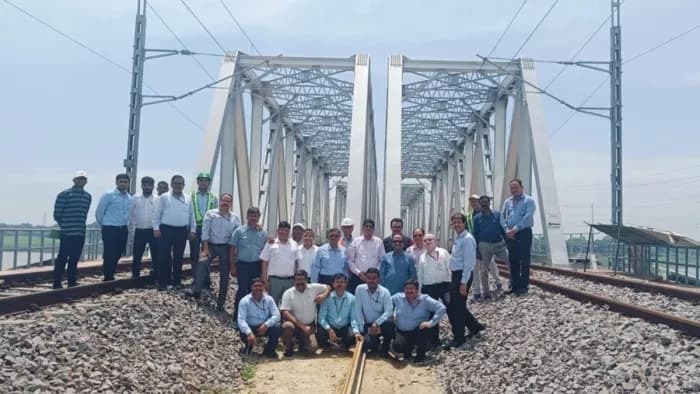
Prayagraj. The rail car ran at a speed of 100 on the Naini new rail bridge on Saturday. The rail car left DDUN at 9 am and reached New Kanpur station at 1.05 pm, covering a distance of 337 km in four hours and five minutes at an average speed of 82.53 km per hour. While the speed of the inspection rail car on the new Naini bridge was 100 km per hour.This is the first such incident in the 159-year history of the bridge built over Yamuna. The officials who witnessed this historic moment applauded and greeted everyone. This was a special trial to run a freight train at a speed of 100 kmph on the DFC track from Sujatpur to DDU.
Train movement started on the old railway bridge built at Naini on the Yamuna river from 15 August 1865. This bridge was built by the British. After this, a new Yamuna bridge was built by DFCIL. After the bridge built by the British, this is the first Yamuna bridge which has been built to carry cargo.
Freight trains started moving on the new DFC bridge on 13 January 2023. On Monday, a rail car ran on this bridge for the first time at a speed of 100. 159 years have passed since the first train ran on these two bridges built on the Yamuna and now another new chapter has been added to it.
History of Naini Bridge
The bridge over the Yamuna at Allahabad was an important link in the East Indian Railway's attempt to connect Calcutta with Delhi soon after the advent of railways on the Indian subcontinent. Its location between Naini and Allahabad was decided as early as 1855. Actual work began in 1859 after the revolt and the bridge was opened on 15 August 1865 under the guidance of Mr. Sibley, Chief Engineer, to connect Delhi-Howrah.
The length of this bridge is 3,150 feet (960.12 metres). It has two spans of 200 feet each and 14 spans of 60 feet each. The bridge has a railway line above it and a road below it. It was designed by engineer Randel. The depth of the foundation below is up to 42 feet and the height of the bottom of the girder from the lowest water level is 58.75 feet. The weight of the girder is 4,300 tons.
It is estimated that about 2.5 million cubic feet of masonry and brick work was used in it. The total cost of construction at that time was Rs 44,46,300, of which Rs 14,63,300 was the cost of the girder. A unique feature of this bridge is its 13th pillar, which is shaped like an "elephant's foot".
New Yamuna Rail Bridge to be launched in 2023
A notable steel bridge has also been built by DFCCIL over Yamuna River (Prayagraj). It is the longest bridge (1034 m) over the Yamuna River and in Prayagraj. It is the longest bridge of the Eastern Dedicated Freight Corridor and has 17 spans, 34 girders, and double-line track was built.
It is built to connect the eastern part of India with the northern part to allow movement of heavy cargo, and minerals and to ensure safe, smooth train operations. It all started in 2016 with the survey for the construction of the 1034 m long two-way bridge which was built with the help of the cofferdam method and caisson technique (the foundation of 18 wells of 9 m diameter with a depth of 45-50 m).
Also, the height of its pillars ranged from 12.4 meters to 16.4 meters. All the 34 girders weighing 9520 metric tons are indigenous and made in India, making it a remarkable piece of structure. It is a futuristic bridge designed keeping in mind the possibility of surface and waterway transport for cargo movement connecting rivers, making India a logistics hub and creating a self-reliant India.
Its optimal use will achieve the objective of reducing logistics costs. Apart from this, a trial run was also conducted on Saturday to increase the sectional speed from 75 kmph to 100 kmph between New Khatauli and New Pilkhani (UP and DN), which was successfully completed.
--Advertisement--

 Priya
Priya Share
Share



